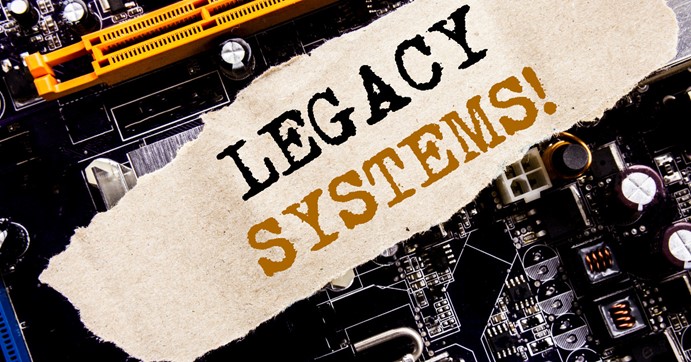For more information on your charming neighborhood CSW Solutions, visit us at our home or subscribe to our newsletter! We also do that social networking thing at: Twitter, Facebook, Linkedin, and Instagram! Check out our #funfactfridays
What is a Legacy System? Should You Upgrade?
The term legacy system was first used in the 1970s to describe computer systems in general. By 1985, it was used more colloquially in reference to existing IT systems to differentiate between ultra-modern systems around that time. A legacy system can either mean the technology or equipment is out of date or both, but they can also have multiple computer systems that do not share data with each other effectively. In the case of the latter, these siloed systems are also considered legacy. Finally, if there is no longer vendor support or future versions being released for purchase, or the system/application is no longer relevant to the company's needs, it would also be considered a legacy system. In this context, the term "legacy platform" and "legacy app" all mean the same thing, and such legacy types can vary in size and age.
There are many accounting, clinical, pharmacy, and purchasing systems that are considered legacy systems. As of 2011, the US Navy still used MS-DOS with some of its legacy applications. in fact, the US government is one of the world’s most significant users of legacy systems. According to Forbes, the majority of the US government’s critical infrastructure is running on legacy systems. Everything from nuclear power plants to air traffic control. ATMs or cash machines even still use Windows XP with their legacy systems even though XP hasn't been supported since 2014. In short, legacy apps still power important business processes in major organizations all over the world.
For the end-user, when a system they are using transforms into a legacy system, they will no longer get updates or security fixes. It's basically like owning an iPod right now. Or an iPhone that is more than a few years old!
Companies often struggle with the decision to replace or get rid of legacy systems because they had already invested a lot of time, money, and effort into acquiring the system, supporting, and implementing it over the years. While these systems may have served them well in the past, they are now hindering their ability to compete in the modern business world.
If your business is using a legacy system, it's important to understand the challenges and advantages of doing so. With this knowledge, you can make informed decisions about whether to keep using the system or work around the challenges. In this blog post, we'll discuss the challenges of legacy systems and how to overcome them.

LEGACY SYSTEM CHALLENGES
One of the biggest challenges of legacy systems is that they are difficult to maintain. Enterprise businesses must constantly invest in new hardware and software to keep their legacy systems running or to make up for the things the system or application cannot do. This is a common inefficiency that is overlooked as a minor inconvenience. But the world of software development and cloud is never still. This not only takes up valuable resources, from IT support to researching ways to fill in gaps, but it also increases the risk of downtime and data loss.
Another challenge of legacy systems is that they are often not compatible with new technologies. This can make it difficult to integrate new applications and technologies into the existing system. As a result, companies are forced to either keep using outdated technologies or make a complete switch to a new system, and the latter can be very costly when you aren't prepared for it. Another aspect that comes at a high cost is faulting, that sometimes leads to great losses. Therefore, modernization of outdated systems eliminates errors and hence improves efficiency.
Security is possibly the biggest challenge of a legacy system. Old-school systems or applications were designed in times when security regulations were not that strict or possibly just didn't exist, and the cost of a breach was small. Today, security threats are coming from all sides. Worse yet, they are getting smarter and more complex. A legacy system can be a liability when it comes to the safety and stability of data.
Finally, legacy systems can also make it difficult to scale. As businesses grow, they often need to expand their legacy systems to accommodate new users and harness data. This can be a costly and time-consuming process.
LEGACY SYSTEM ADVANTAGES
Despite these challenges, there are many advantages to using legacy systems. For one, they are often more stable and reliable than newer systems. They also tend to be less complex, which makes them easier to manage. There is always something comforting about that familiar interface for old users.
Additionally, legacy systems often have a lower total cost of ownership than newer system but that's only if you ignore the amount of time, staff, and resources required to maintain it leading up to the current state of operations.

LEGACY SYSTEM SOLUTIONS
There are also new methods for the modernization of outdated systems, which will not only increase the efficiency of operations but also rise the probability of return on investment when you want an alternative solution or you just want to take it step by step in phasing out your legacy system. Legacy system modernization is the first step on the way to digital transformation.
System Automation
The natural step for modernizing your legacy system. There's a lot to be said about the diligence of manual processes in legacy systems, but times are a-changing, and nothing save time and energy better than automated workflows! But I'm getting ahead of myself here. There continue to be new ways to automate legacy systems to streamline operations, reduce overhead, and significantly reduce chances of human error or interruption due to lack of access.
Migration to Cloud
Cloud computing has revolutionized the way data is stored and accessed. With the cloud, users can connect to a virtual space where they can share resources, software, and data. A successful digital transformation of legacy software development cannot omit a shift to the cloud. Cloud collaboration enables companies to upload data to a virtual central server, allowing users to access digital assets stored in one place anytime.
Containers
We have written about containers and how they work before. You can see that post here. A container is an ideal alternative solution to use in modern, cloud-based environments where infrastructure services are always changing or updating. A container solution is also a more convenient option because they are more portable and scalable than traditional applications. Applying a container-driven solution means that a company can remove dependencies on the outdated infrastructure services and embrace automation on another level.
DevOps
Although it sounds like magic for modern clients, DevOps is a business strategy that can save money while expediting certain processes without losing the effectiveness of the legacy system. That’s the reason why many decision makers call on DevOps consultants to analyze the whole system and provide a qualitative list of services or add value with integration that can revolutionize operations. A good DevOps will find Azure services, such as industry-specific cloud solutions, that will decrease the cost of data storage on your local server and increase the level of effectiveness the system provides for the business.
Responsive Technologies
While most businesses and corporate organizations have already embraced the mobile revolution, many are already applying responsive technologies to their legacy systems. Mobile-driven systems improve the user experience and preemptive measures to meet the mobile demand of hybrid work, means that you'll have secure infrastructure where data and interface stay consistent across all devices without compromising data.
AI-Powered Analytics
AI-power solutions have been creating ample solutions with programmable, human-like tasks easier for more and more companies. You can accomplish specified tasks by also analyzing huge amounts of data and recognizing data recurrent patterns. AI-powered analytics also offer intelligent databases with built-in AI that can monitor and compare operational data and compare to prescribed parameters to sort out inefficiencies or locate errors that could have been previously overlooked. AI can provide valuable insight and lead the way to more informed decision-making across the board.
Big Data
Big data is the new norm. The world of business speaks the language of big data for its ability to: quickly gather, compile and segment relevant information about products and services sold in the market; better target consumers; understand the impact of sales and marketing efforts on profitability. However, before big data can fulfill its potential as a business driver, it must be handled efficiently. Today, legacy system optimization plays a very important role in putting big data to good use in order to drastically increase an organization’s marketing ROI. Previously, legacy systems have proven to be ineffective when it came to modern marketing strategies that require real-time data input and analysis. Legacy systems have been ineffective because they were not set up to handle big data.
In order to stay competitive in an ever-evolving market, organizations must be able to capture and facilitate their internal and external data to get the most out of it. However, many legacy systems still depend on flat files and hierarchical databases, thus over complicating any potential data mining. This is an essential feature for most modern technologies that we have already mentioned here. To modernize data, legacy system databases would have to be replaced with modern databases. This is the only way a business can continue to operate with efficiency while serving the end user with a branded experience and better yet, stay competitive.
The world has already gone through a lot in recent years and digital transformation was at the forefront of change for many businesses that needed to adapt to gain ground as the forward momentum waxed and waned, no matter their industry. Emerging technologies are and continue to create more challenges for those businesses who are just getting into the digital space. In order to stay competitive, companies and organizations must keep up with them while embracing the opportunities they offer. One of the biggest obstacles for a business of any size, is their legacy system and whether it needs to be modernized, maintained, or decommissioned for the sake of the future. Modernizing of any legacy system will open the door to new possibilities for companies to improve their business efficiency and enhance their workflows.
CSW Solutions is a technology and cloud consulting firm specializing in legacy system optimization for small to enterprise-level software development for businesses. With over 20 years of expertise, we have mastered the skills and tools necessary to modernize legacy systems, create hybrid solutions to phase out systems, and developing an efficient and streamlined business process for our clients. You are welcome to reach out to us any time to discuss ways to modernize your business!

